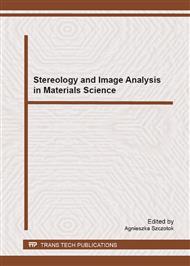p.119
p.125
p.131
p.137
p.143
p.149
p.155
p.162
p.168
Stereological and Statistical Evaluation of Grain Size in Experimental Ni-Based and Conventional Supercoarse Sintered Carbides
Abstract:
Chemical composition and technology of experimental Ni based binder-tungsten carbide particles composite have been worked out to increase corrosion resistance of conventional supercoarse WC-Co type sintered carbides. All the sintered WC cermets, both with Co and Ni-based binding phase have been manufactured using identical supercoarse WC powder. Grain size evaluation was performed using light microscope images and grain chord length measurements, samples of commercial WC-Co coarse and supercoarse grades being included into analysis for comparison purposes. The obtained statistical and geometrical distributions of the chord length revealed certain differences. The performed statistical analysis allowed to state that the investigated experimental grades of Ni-based sintered WC carbides are materials of microstructure significantly more coarse than the reference coarse commercial grade (i.e. they can be classified into supercoarse group of sintered carbides).
Info:
Periodical:
Pages:
143-148
Citation:
Online since:
February 2013
Authors:
Price:
Сopyright:
© 2013 Trans Tech Publications Ltd. All Rights Reserved
Share:
Citation:


